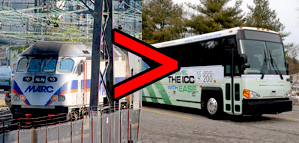|
Special Features





Image Libraries


|
|
Blog
The new uniform paint job taxicabs are starting to appear in DC. Twitter user @TPozen spotted one yesterday.
It’ll take years before most cabs look like this, but someday this look will be as familiar to Washingtonians as yellow-and-black cabs are to New Yorkers.
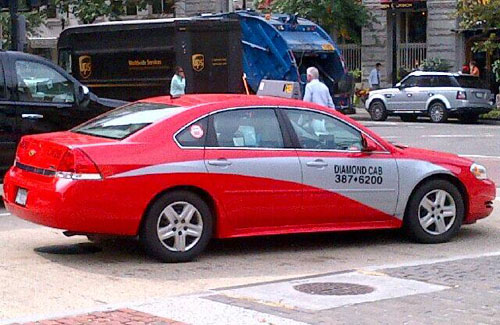
Photo by @TPozen.
Average Rating: 4.6 out of 5 based on 223 user reviews.
October 4th, 2013 | Permalink
Tags: roads/cars, transportation

Today is Park(ing) Day, and all across the US city-dwellers are claiming car parking spaces and temporarily converting them to parks for people.
Instead of using all our street space to store cars, why not use some of it to make our cities nicer places to live? On Park(ing) Day, groups find an on-street parking space, pay the meter to claim it legally, and instead of parking a car, they park seats, tables, plants, or whatever.
Groups are sponsoring parklets all over the DC region today. I visited two near my Arlington office alone.
 |
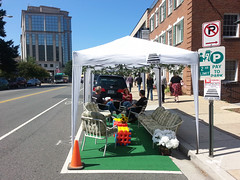 |
| Parklets on Clarendon Boulevard (left) and 14th Street North (right). |
 Cross-posted at Greater Greater Washington. Cross-posted at Greater Greater Washington.
Average Rating: 4.6 out of 5 based on 268 user reviews.
September 20th, 2013 | Permalink
Tags: parks, roads/cars, transportation, urbandesign

Fun things hide in city planning office storage rooms. I recently stumbled upon this fascinating Washington Post special from the 1982 day I-66 opened.
My favorite part: “I-66 means that the days of the great highway wars are ending.” LOL.
The full story is online.
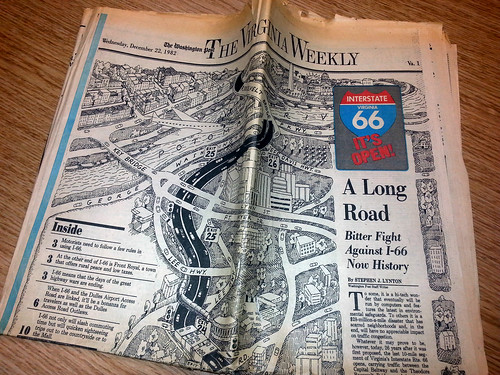
From December 22, 1982.
Average Rating: 5 out of 5 based on 299 user reviews.
September 13th, 2013 | Permalink
Tags: fun, roads/cars, transportation

|

Almost $20 million will go to new VRE railcars. |
For years, leaders in Northern Virginia have been asking Richmond to let Northern Virginia raise its own money to spend on its own transportation priorities. They are finally getting the chance.
When the Virginia General Assembly passed a broad new transportation funding bill earlier this year, it included a section for Northern Virginia to raise and allocate hundreds of millions of dollars per year. Those new taxes began rolling in on July 1, with the beginning of Virginia fiscal year 2014.
On Wednesday night, the Northern Virginia Transportation Authority (NVTA) officially approved its first set of projects. The authority allocated about $210 million, split roughly evenly between transit and roads.
The largest projects include the Silver Line’s Innovation Center Metro station, new VRE railcars, and widenings along Route 28.
NVTA also approved a bond validation lawsuit that will preemptively ask Virginia courts to rule on NVTA’s legality. That process should take 6-9 months, and NVTA will have to wait until it’s over to actually start spending money. Taking the suit to court now means NVTA won’t have to spend years fending off other legal challenges.
The project list is shown below. For more details, see the project description sheets on NVTA’s website.
| Project |
Funding
in millions |
Location |
| Transit and multimodal projects |
| Innovation Center Metro station |
$41 |
Fairfax Co. |
| VRE railcars |
$19.8 |
Regional |
| VRE Lorton station 2nd platform |
$7.9 |
Fairfax Co. |
| WMATA buses |
$7 |
Regional |
| WMATA Orange Line traction power upgrades for 8-car trains |
$5 |
Regional |
| DASH buses |
$3.3 |
Alexandria |
| Potomac Yard Metro station environmental study |
$2 |
Alexandria |
| Crystal City multimodal center bus bays |
$1.5 |
Arlington |
| VRE Gainesville extension planning |
$1.5 |
Regional |
| VRE Alexandria station pedestrian tunnel & platform improvements |
$1.3 |
Alexandria |
| Herndon Metro station access improvements (road, bus, bike/ped) |
$1.1 |
Fairfax Co. |
| ART buses |
$1 |
Arlington |
| Leesburg park and ride |
$1 |
Loudoun |
| Loudoun County Transit buses |
$0.9 |
Loudoun |
| Route 7 Tysons-to-Alexandria transit alternatives analysis (phase 2) |
$0.8 |
Regional |
| Falls Church pedestrian access to transit |
$0.7 |
Falls Church |
| Duke Street transit signal priority |
$0.7 |
Alexandria |
| PRTC bus |
$0.6 |
Prince William |
| Alexandria bus shelters & real-time information |
$0.5 |
Alexandria |
| Van Buren pedestrian bridge |
$0.3 |
Falls Church |
| Falls Church bus shelters |
$0.2 |
Falls Church |
| Road projects |
| Rt 28 – Linton Hall to Fitzwater Dr |
$28 |
Prince William |
| Rt 28 – Dulles to Rt 50 |
$20 |
Fairfax Co. |
| Belmont Ridge Road north of Dulles Greenway |
$20 |
Loudoun |
| Columbia Pike multimodal improvements (roadway, sidewalk, utilities) |
$12 |
Arlington |
| Rt 28 – McLearen to Dulles |
$11.1 |
Fairfax Co. |
| Rt 28 – Loudoun “hot spots” |
$6.4 |
Loudoun |
| Chain Bridge Road widening |
$5 |
Fairfax City |
| Boundary Channel Dr interchange |
$4.3 |
Arlington |
| Rt 1 – Featherstone Rd to Mary’s Way |
$3 |
Prince William |
| Edwards Ferry Rd interchange |
$1 |
Loudoun |
| Herndon Parkway intersection with Van Buren St |
$0.5 |
Fairfax Co. |
| Herndon Parkway intersection with Sterling Rd |
$0.5 |
Fairfax Co. |
 Cross-posted at Greater Greater Washington. Cross-posted at Greater Greater Washington.
Average Rating: 4.5 out of 5 based on 248 user reviews.
July 26th, 2013 | Permalink
Tags: BRT, bus, commuterrail, funding, government, lightrail, metrorail, roads/cars, transportation

|
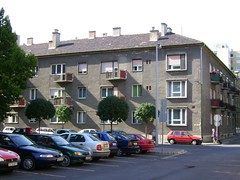
Photo by photobeppus on flickr. |
DC planning director Harriet Tregoning announced today that minimum parking requirements in transit-oriented neighborhoods will remain in the new zoning code.
As part of its rewrite of the zoning code, DC’s Office of Planning (DCOP) had proposed eliminating mandatory parking requirements in the densest, most transit-friendly parts of the city. Anyone who wanted to build parking would still be allowed to do so, but it wouldn’t be mandatory. The new zoning code will lower requirements for parking, but won’t eliminate them completely.
The new proposal will keep parking requirements for institutional and industrial land uses similar to what they are now. The requirement will drop by about half for residential and office buildings.
Under existing zoning, any new residential units are required to build parking spaces, whether the owner wants them or not. The requirement is a huge subsidy for drivers, and a major burden on car-free households. It also adds tremendously to the cost of new housing.
There is a silver lining: DCOP is still planning to eliminate parking requirements in downtown DC.
 Cross-posted at Greater Greater Washington. Cross-posted at Greater Greater Washington.
Average Rating: 4.4 out of 5 based on 229 user reviews.
July 12th, 2013 | Permalink
Tags: government, roads/cars, transportation

I’ve never seen anything like Moscow’s Zhivopisny Bridge before. It’s technically a cable-stayed bridge, like many around the world, but the giant perpendicular archway pier is totally unique.
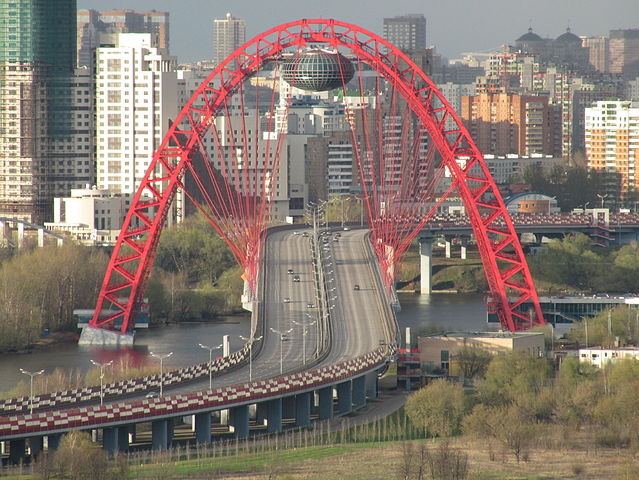
Photo from Wikipedia user Daryona.
Average Rating: 4.7 out of 5 based on 171 user reviews.
June 12th, 2013 | Permalink
Tags: architecture, roads/cars, transportation

Do you own a car in Maryland? You can advertise your urbanist ways with a special license plate.
The plates are technically to advertise LiveBaltimore.com, which provides services to help potential home buyers in Baltimore.
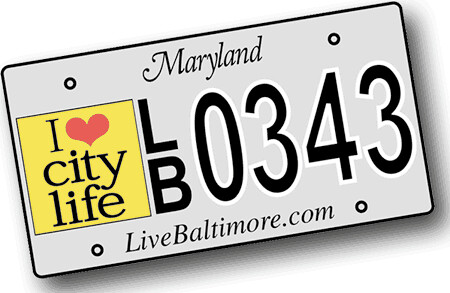
Average Rating: 4.4 out of 5 based on 162 user reviews.
May 23rd, 2013 | Permalink
Tags: fun, roads/cars, transportation

Arlington Memorial Bridge opened in 1932, amidst the very depths of the Great Depression. It was a major event in Washington, which drew President Herbert Hoover, the first lady, and the vice president.
This vintage newsreel illustrates the excitement. The newsman is particularly enthusiastic that the bridge is wide enough for “4 cars to pass abreast.”
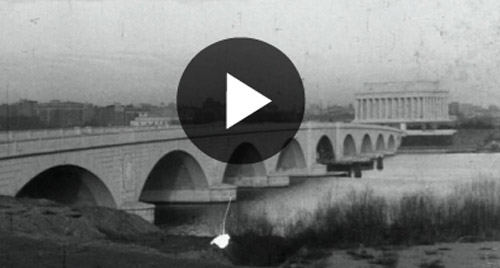
Video from British Pathe.
By the way, did you know the bridge doesn’t actually go to Arlington? Both sides are totally within the District of Columbia.
It’s a common misconception that the boundary between DC and Virginia is the middle of the Potomac. But in fact, the entire river is part of the District. If you are standing on the Virginia shore and step one foot into the river, you have technically crossed into DC.
The Memorial Bridge technically connects mainland DC and Columbia Island. The island is best known for the traffic circle on the far side of the bridge, often-confusing ramps on and off the George Washington Parkway, unsafe pedestrian/bicycle crossings, and Park Police who yell at drivers when they stop for pedestrians.
Since Columbia Island is fully within DC, so is Memorial Bridge. The actual Virginia boundary is along the much-shorter Esplanade Bridge, between Columbia Island and the Virginia mainland. This also means the GW Parkway and Mount Vernon Trail are partially within DC, since they run through Columbia Island.

DC/VA border. Image from Google.
Periodic protest organizer Adam Kokesh might benefit from consulting this map. He’s trying to lead a July 4th march with guns on DC, but since DC prohibits carrying guns around, including loaded ones, he’s now planning to march on the Memorial Bridge up to the District line and meet police there. He might have a hard time, since the District line doesn’t cross the Memorial Bridge.
 Cross-posted at Greater Greater Washington. Cross-posted at Greater Greater Washington.
Average Rating: 5 out of 5 based on 211 user reviews.
May 22nd, 2013 | Permalink
Tags: history, roads/cars, transportation

There was good news and bad news for Maryland transit yesterday.
The bad news was Maryland’s decision to cut bus service on the ICC. The good news was that the Purple Line, Corridor Cities Transitway, and Baltimore Red Line are all advancing, and that MARC’s Penn Line will start running on the weekend.
Overall, that’s a huge net gain for transit in Maryland.
The new BRT and light rail lines are still years away, but weekend MARC service could start as soon as this winter. The MARC news alone is a bigger win for transit than the ICC buses are a loss.
Not that there’s actually any trade here. MARC isn’t expanding service because ICC buses are going away. The two are unrelated. Just that, as a transit user, if I were given the choice between those two things, I’d definitely pick weekend MARC.
And although Maryland is deservedly criticized for the ICC, it’s also worth noting that the ICC is in the past, and the state’s current plans are extremely progressive.
Most of the new state’s new transportation money is going to transit instead of roads, and most of the road projects are relatively reasonable. There are plenty of proposed interchange improvements and widenings, but there’s no sprawl-inducing, traffic-generating outer beltway.
Average Rating: 4.8 out of 5 based on 271 user reviews.
May 17th, 2013 | Permalink
Tags: BRT, bus, commuterrail, lightrail, roads/cars, transportation

|
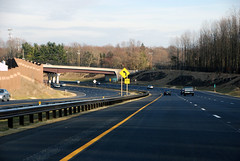
The ICC. |
Maryland may eliminate 3 of the 5 bus routes on the Intercounty Connector. The move is a classic bait and switch from highway builders: Get political buy-in with the promise of a multimodal road, then cut the multimodal aspects at the first opportunity.
The Maryland Transit Administration operates 5 bus routes on the ICC. They’re proposing to eliminate routes 202, 203, and 205. Only the 201 and 204 would remain, running from Gaithersburg to BWI and Frederick to College Park.
When planning the ICC, Maryland promised it would include good transit service and a high quality bike trail. They cut much of the trail in 2004. The bus service was never very good either, so it never got many riders. Now the state is citing that as a reason to cut it significantly.
Of course, cars aren’t held to the same standard.
There also aren’t many drivers on the ICC. Around 21, 000 cars per day use the road. The state says that meets projections, but the projections seem to change. At one point they were as high as 71, 000.
But is anyone proposing the state shut the road? Nope. Instead, the strategy is to try and boost car use.
Lawmakers hoped to induce more traffic with lower tolls last year, although that proposal was never accepted. This year the state raised the speed limit to make driving more attractive.
When it comes to bikes and transit, it’s cut and run at the first hint of a problem. For cars, it’s roll out the red carpet and hope for more traffic.
This isn’t the first time this has happened. When Virginia’s I-95 HOT lanes were first proposed, the firm hoping to expand the highway called its proposal “BRT/HOT lanes, ” but of course nothing resembling actual BRT was ever built.
Transportation advocates should remember this the next time someone proposes a “multimodal” highway. Odds are they won’t deliver.
 Cross-posted at Greater Greater Washington. Cross-posted at Greater Greater Washington.
Average Rating: 4.9 out of 5 based on 287 user reviews.
May 16th, 2013 | Permalink
Tags: bike, bus, roads/cars, transportation

|
Media





Site
About BeyondDC
Archive 2003-06
Contact
Category Tags:
Partners
|





















